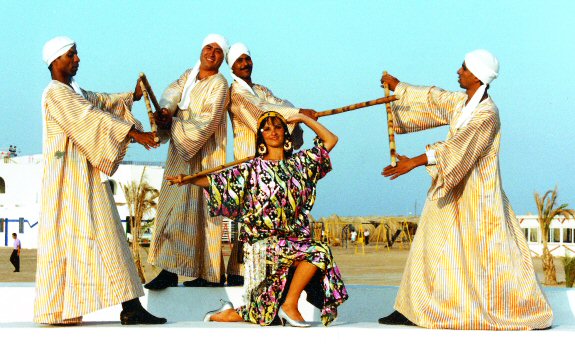BIOGRAPHY
Sonja Asmahan
Sonia Asmahan´s life was full of dance and adventures. In her youth she first discovered her love of martial arts and then the world of dance. After a basic training in Middle Eastern dance she travelled to Egypt to take dance classes. The fascination for Arabic rhythms and sounds, the way of movement and the country and its people were so fascinating that packed her costume into her back pack and hitchhiked a ride in a truck to turkey.
She travelled through the country and collected first hand experience in dance from the Roma. Then she travelled to Egypt, visited the oasis and lived in the Sinai in caves and huts with the Bedouins.
Money became tight, and she took a job as an activity leader in a club hotel and in the evenings she performed on stage. A trip to Cairo made her famous in the whole Arab Wold: She was offered a main role as “Rasha Lotfi Damanhouri” beside the famous actors Mohamed Sobhi and Gamil Ratib in the second Egyptian TV series “Sonbol” (Sonbol baed el Million), playing in Arabic and French.

Overwhelmed and dismayed by this fame, which came too fast, she left Cairo and went back to the desert presenting dance shows for several years with her own orchestra and folklore group in four and five star hotels. She was the first German Middle Eastern dancer performing in Egypt.
Shortly there after she was married and founded with the Choreographers Hoda Ibrahim and Tamer Yehya the Dance School “ALMANAR . in Hurghada/Egypt, which now has its second seat in Stuttgart/Germany.
The love of adventure returned back and she travelled with her husband to Yemen, exploring places where had have never seen tourists before. After that she lived with her family in Saudi Arabia, learning the “Khaleegy Dance” (Golf Dance) and organised parties and events for women in luxury 5 stars hotels.
She moved to Tunisia, where she was granted the Artist's Card (Artist of Middle Eastern Dance) by the Tunisian Ministry of Culture, performed in hotels and culture centres and studied the Traditional Tunisian Dance from the master of ballet Khira Obeid Allah. In all those years she continued to improve her dance. Meanwhile she became a dancer, able to present Middle Eastern dance at a very high level. She presented this art in the way in which is still common in the Middle East: In Free style. A performance in free Style needs a highly musicality, knowledge of the language, talent to improve and intuition. This is an incredible for a person who is not Arabic. That´s why the performance of “Nugum” (prod. Fadhel Jaziri + Samir Agrebi) at the Amphitheatre of Carthage for an audience of 10.000 was an absolute highlight for her. Real ability and self-confidence was required to present Middle Eastern dance in “free Style” with live music in front of such a big crowd of people.
After a painful separation she went back to Germany and brought her son up on her own. In the most chaotic time of her life, full of familiar conflicts, difficult relationships and struggle for survival, the dance always was her best friend. It was her support, consolation and outlet for her artistic and personal self fulfilment. She needed time to digest those painful experiences.

Always thirsty to learn new styles she increased her repertoire with ballet, flamenco, Modern + Jazz Dance, Musical Show Jazz, Yoga, Martial Arts and especially the Street Dance.
There the artist felt immediately at home, because the Middle Eastern dance is in its origin a Street Dance too. She fell in love with the expression of the Street Dance and because she always was free styling anyway. Sonia created her personal style: combining the oldest and most feminine dance of the world, the dance of mother earth, with the contemporary martial character of the Street Dance. “HIP ISO® Hip Isolation Oriental Style” www.hip-iso.de is wild, authentic feminine and bursting with energy.
Sonia Asmahan was hired by the city of Stuttgart in 2004 she and her company presented on the occasion of the 25th jubilee of the twin cities Stuttgart and Cairo the Dance theatre “Magic of the desert” (arab.) “Saher Essahra” in German and Arabic.
When she was in Egypt the dancer loved to sing Arabic songs with the musicians entertaining the guests after the show. But she never thought of becoming a singer. Now she feels that she wants to express herself in song as well. The multitalented artist meanwhile sings and writes songs in German, English, Arabic and French. Her positive-minded lyrics are about drug abuse, murder for honour, integration, suppression and psychological injuries. Her music is a mix of international music, Hip Hop and Rock, and an appeal to dance, music and identification process and is like the artist herself: wild, authentic and naturally.
Sonia Asmahan promotes the spread of dance battles as an aggression- and drug prevention at schools, youth centres and for the integration of immigrants.
 top top
|